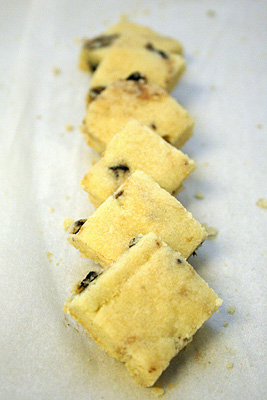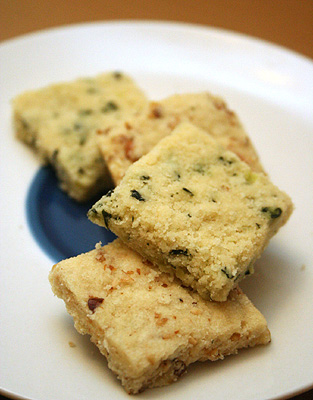This shortbread has such a short ingredient list that you might be tempted to overlook it. There’s no chocolate or vanilla. Not even eggs or baking powder/soda. There’s just flour, sugar, butter, and salt (and a secret flavoring agent).
Despite its simple nature, there’s an amazing number of things that can go wrong with shortbread: it comes out too plain, hard, dry, doughy, greasy, or stale-tasting. But you can’t mess up shortbread if you make olive cookies (scourtins) [2] from the reputable French chef, Susan Loomis [3]. The dough is crisp yet delicate. Every bite melts in your mouth. The olives don’t overpower the cookies, either. Whether you can taste it or not, every dessert has a pinch of salt to round out the flavors [4]. In this case, the salt predominantly comes from the olives. (For more olive oil desserts, try making chocolate mousse [5], truffles [6], or gelato [5].)
The first time I made these cookies, they were supposed to be a birthday gift. Then I ate 10 in one sitting, and I eventually had to re-bake an entire batch. They were so addictive that I made about six more batches after that (as gifts, of course). They’re the most repeated dessert I’ve made all year.
Since the genius of these cookies is their unusual source of salt, I thought of another savory substitute: seaweed. I know vegetables don’t sound appetizing in cookies, but just think of seaweed as the complex version of sea salt.
When I thumbed through my pantry last night, I saw furikake [8] (a mix of soy-glazed bonito [9] flakes, sesame seeds, and nori) and thought, “Hey, why not? Fish come from the sea, too.” So I made two batches of cookies (which you should always do with this recipe, because you will run out!).
While the furikake tasted great in the raw dough (I loved the sweet-salty combo of the fish and the soy sauce), the fish flakes didn’t keep their crunchy texture, and the flavor became too distracting. It was still tasty, but I preferred the seaweed version.
PS-I conceptualized these cookies a long time ago, but that darn David Lebovitz [10] scooped me. But my adaptation is different, as there’s a lot more seaweed but no egg. For another sweet-savory twist, I bet bacon would be good, and you could substitute some rendered bacon fat for the butter.
Seaweed Shortbread Cookies
This recipe doubles easily (trust me, you will need to double it), so you can munch on the cookies and still have some left for gifting. They stay delicious for weeks and hold up well in the mail.
Adapted from Susan Herrmann Loomis [11] and The Traveler’s Lunchbox [2]
Yield: about 34 cookies
1 stick unsalted butter, softened
3/4 cup powdered sugar, sifted or 1/4 cup plus 2 tablespoons granulated sugar, whizzed in a food processor until fine
1 Tablespoon roasted sesame oil (recommended brand: Kadoya [12])
1 1/4 cups all purpose flour
1/8 teaspoon salt
1/4 cup crushed wakame flakes [13]
Preheat oven to 350° F. Line two baking sheets with parchment paper or foil.
In a large bowl or the bowl of an electric mixer, cream the butter until it is soft and pale yellow. Mix in the sugar until blended, then drizzle in the sesame oil and mix until combined. Add the flour and the salt, and mix gently but thoroughly until the dough is smooth, then add the wakame flakes and mix until they are thoroughly incorporated into the dough.
With your hands, press the dough into the pan until it is 1/4-inch thick. Refrigerate the dough for at least 30 minutes, and up to 24 hours. Score the dough into rectangles with a knife.
Bake until the cookies are golden, about 15 minutes. Remove from oven and immediately cut the cookies while they are still hot. Cool on wire racks.
If you find that the middle pieces are still doughy, re-bake them in a preheated 300° F oven for about 10 minutes.
Variation: Substitute 1/4 cup plus 2 tablespoons bonito-flavored furikake [8] for the arame seaweed. (Furikake is like rice confetti. It’s also a delicious seasoning for cold silken tofu, eggs, noodles, popcorn, and salad. If you want to make your own, Gourmet [14] and Egullet [15] have recipes.)

